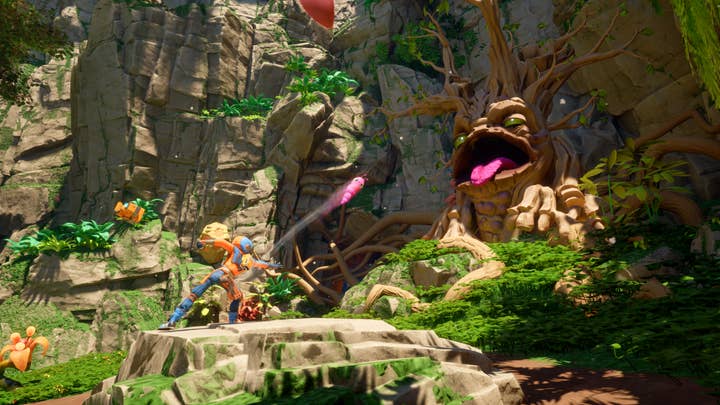As we watch a member of the Raccoon Logic team hop, run, shoot and splat their way through Revenge of the Savage Planet at Gamescom, the studio head and co-founder Reid Schneider tells us the goal “wasn’t to make the expected sequel.”
That’s a tall order, given that Raccoon Logic was formed by folks who had previously been at Journey to the Savage Planet developer Typhoon Studios before it was closed as part of Google’s Stadia shutdown. The team announced from the off that it had managed to reacquire the Savage Planet IP from Google – and confirmed back in April that it was indeed working on a new title in the series.
Like Journey to the Savage Planet, Revenge’s players find themselves on a colourful alien world, exploring and scanning life forms, blasting hostile creatures, gathering resources, and using them to craft or upgrade items. The game also retains its predecessor’s wacky humour, with more than a few digs at the types of corporations who think it’s profitable to colonise space.
So in many ways, it’s very much an expected sequel. How, then, is Raccoon Logic attempting to subvert expectations?
“It’s tough,” Schneider admits. “With the first one, when you make a new IP, it’s kind of like catching lightning in a bottle. The whole time we were making the first game, we were like, ‘Is anyone gonna care about a space game with fart jokes?’ Turns out people actually do care about a space game with fart jokes, so we said, ‘Okay, how could we go much bigger and broader on this?'”
In Schneider’s view, the expected sequel would be “a couple more planets and staying in first-person.” Revenge of the Savage Planet lets players loose on four planets, has a whole new colony area they can customise between expeditions, and most notably shifts to a third-person perspective.
“We felt like there’s a lot of opportunities that we could take, especially with comedy, by pulling it into third-person,” Schneider explains. “There’s more physical comedy now – slapstick is a big touchpoint for us – and it just felt like we wanted to go do something much bigger, better, unexpected, surprising.
“If we were ever going to do it, we’re going to do it now because as an indie developer, we own the company and we can go do it.”
Art director and fellow co-founder Erick Bilodeau adds that the third-person perspective was actually considered during the production of the first game, particularly when working on the platforming elements.
“We already had all the animation of third-person because of the co-op. So we had this cheat mode where we could put it in third-person and test it, but it was not ready to be shipped. So that’s one of the first things we wanted to experiment with when we started working on this one.
“The main motivation behind it is to convey humour because now you see a character. There’s not a lot of things you can emote with just two hands on screen. But now we have the full character, you see the janky animation, and we can convey humour to the character.”
Much of the humour is also found in the story. As with the original, you play an employee of a vast corporation set on colonising space. This time, however, the company you work for decided space exploration was too costly and unprofitable while you were in cryosleep, so you’re made redundant before you even wake up.
It’s hard not to assume this is a dig at Google, the team’s former parent company, given that Typhoon Studios was shut down before it ever got to make its first project as part of the Stadia business (Journey to the Savage Planet was already well into production before the acquisition). However, creative director and co-founder Alex Hutchinson says this story is more inspired by the industry’s experience with layoffs and studio closures over the past two years.
.jpg?width=720&quality=70&format=jpg&auto=webp)
“It’s a story about all of those companies who got caught up in an exciting moment, and then [the people who were] turfed out by large multinationals”
Alex Hutchinson, Raccoon Logic
Since corporations were central to the theme of the first game, the team wanted to considered what those companies would have done in the following years. For this, they looked at what’s happening with corporations and game companies today, with Hutchinson noting that the studio itself was among those “acquired and then discarded.”
“We’re an example of it, but it’s not a story about us,” he says. “It’s a story about all of those companies who got caught up in an exciting moment, and then [the people who were] turfed out by large multinationals. So it’s not specifically about Google at all.”
Schneider adds: “Google is obviously in the ether, but there is a much wider feeling in the industry that we’re seeing [with] all the studio closures – we all saw the stuff with Embracer. It felt like the timing of this was right.”
Raccoon Logic has also made changes to how the game is developed. As with Typhoon Studios, the team has been kept small – 30 people plus some contractors – but this time things are much more organised. When talking about the studio structure during development of Journey to the Savage Planet, Schneider says: “Scrappy doesn’t even begin to describe it.”
For Revenge, producer Noémie L’Écuyer tells us the production schedule has been divided into three main phases: conception, production and polish.
“This allowed us to essentially have an alpha midway through. It really gave us enough time to polish the game and ask ourselves the real questions. It’s a really collaborative approach as well, a lot of people have a lot of opinions, lots of input – it’s the perfect size team to do that.”
Hutchinson adds: “I think there’s much more ownership when you have a small team. Everyone gets to touch everything. On some of those big AAA teams, half of you probably [don’t] even know the game that they’re making, you just know the high concept. For the first first time ever in my career of 20-plus years, the whole team is playing the game all the time and actually giving feedback on it.”

Many of the Raccoon Logic team are former AAA developers, with Hutchinson himself previously serving as creative director on Ubisoft’s Assassin’s Creed 3 and Far Cry 4. When you have hundreds of people working on a title, he posits, most people make just part of the game – and that work can sometimes be lost entirely.
“We had an awful moment at Ubisoft, I think it was on Far Cry 4, where we were editing the game at the end,” he recalls. “We were cutting three missions because they just didn’t fit the flow. They were fine but they felt too slow and we wanted to speed up. And we realised we were cutting the work of one level designer; that was the entirety of his years on the project. It was the right thing for the game, but that’s all he’d done so it was kind of depressing.”


A smaller team means everyone has more of a chance to contribute, and also means a game that’s smaller in scope. The team tells us Revenge of the Savage Planet is likely to be 15 to 20 hours long, up from Journey’s ten to 12. Again, this plays up to the expectation that sequels are noticeably longer; we ask if there’s pressure when making a follow-up to ensure it’s significantly bigger and better than its forebear.
“I don’t think that’s true after the second one,” Hutchinson says. “With the first one, you always leave a lot of stuff on the table, and it’s usually about what you can get done. It’s not necessarily the perfect size for the game that you’re making. This one is not radically longer than the first one, but it’s much more finished, denser, and much more polished.”
As for the team’s expectations for Revenge of the Savage Planet, things are a little unclear – largely because Hutchinson admits that the team is “not really 100% sure” how well the first game did due to the scattered launches across different platforms and under different publishers.
“We know we’ve had [over] four million players and that, just in the last couple of months when it was re-released on Xbox, almost half a million people downloaded it on that platform,” Hutchinson says. “So we’re hopeful there’s a real audience out there, but the modern market is very challenging in that there’s subscriptions, and where things go and how they’re bought is changing.”
Finally, we ask about the challenge of educating potential players ahead of Revenge’s launch. Journey to the Savage Planet sounds like it had a decent audience, but perhaps didn’t set the industry alight. The perspective has changed, the structure is slightly different, and even the developer has changed its name. How can players know what to expect?
“In the modern market, each game has to stand on its own,” Hutchinson says. “You can’t do sequels that require knowledge from the last one. Even the Marvel Cinematic Universe found out that, like the comic industry it’s based on, after a certain amount of time, there’s too much information to retain. It’s fun to know a little bit but if you’re 17 movies in and you missed the TV show… This is a standalone game. If you played the first game, you’ll get a lot of in jokes and you’ll get some extra content, but you don’t need any information from the first game.”
Schneider adds that the team is keen to support the game long after launch and is currently in discussions with Tencent, which is helping to fund the project, to work out what this looks like. For now, the focus is on self-publishing the game across PC, Xbox, and PlayStation.
“We want to have something that people enjoy, we want to make it better and better as it goes on, but we also want to make sure that we have a really great launch that people respond to well and ideally hopefully – knock on wood – we can do more in the future.”